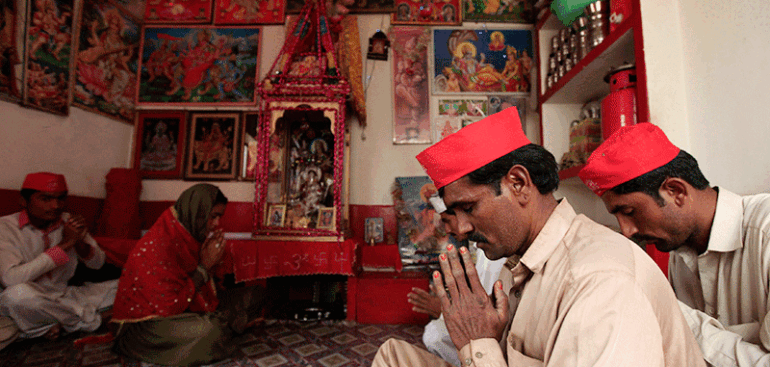The migration of Hindus from Sindh, Pakistan, has been an ongoing phenomenon exacerbated by multiple socio-political, economic, and environmental factors. While the Hindu community in Sindh has historically been an integral part of Pakistan’s social fabric, recent trends indicate a notable increase in their migration. Various reports suggest that security concerns, forced conversions, economic challenges, and environmental changes have compelled thousands of Hindu families to seek refuge elsewhere, primarily in India.
This article aims to provide a factual and data-driven analysis of the migration trends of Sindh’s Hindu population, using census data, human rights reports, and expert analyses.
Demographic Overview
Hindus constitute the largest religious minority in Pakistan. According to the 2023 census, the Hindu population in Pakistan stands at approximately 5.2 million, representing 2.17% of the national population. Of this, Sindh province is home to nearly 4.9 million Hindus, making up 8.81% of Sindh’s population. Certain districts, such as Umerkot and Tharparkar, have particularly high concentrations of Hindus, with Umerkot being the only Hindu-majority district at 54.53%.
Despite their long-standing presence, many Hindu families have been leaving Sindh in increasing numbers, citing deteriorating conditions in various aspects of life.
Key Factors Driving Migration
Several key factors have been identified as major contributors to the migration of Hindus from Sindh:
1. Faith-Based Violence and Insecurity
Numerous reports highlight an increase in faith-based violence against Hindus in Sindh. The Human Rights Commission of Pakistan (HRCP), in its fact-finding report titled “Exodus: Is the Hindu Community Leaving Sindh?”, documents rising cases of attacks on temples, kidnappings, and incidents of religious intolerance.
- One such incident occurred in 2023 when Holi celebrations at Karachi University were disrupted by members of an extremist group, creating a climate of fear.
- There have also been multiple reports of attacks on Hindu places of worship and businesses, further increasing concerns over religious intolerance and discrimination.
A 2020 study by HRCP further noted that Hindu families often feel compelled to migrate due to a lack of state protection and growing religious extremism in various parts of Sindh.
2. Forced Conversions of Hindu Girls
Forced conversions of young Hindu girls have been a recurring issue, particularly in rural Sindh. Reports suggest that minor girls from Hindu families are often abducted, converted to Islam, and forcibly married off.
- According to the Movement for Solidarity and Peace (MSP), around 1,000 girls from minority communities, predominantly Hindus, are forcibly converted each year in Pakistan.
- A 2021 report by the Sindh Commission for Minority Rights stated that many such cases go unreported or fail to result in justice due to institutional bias and lack of legal enforcement.
The fear of forced conversions has led many Hindu families to seek safer living conditions outside Pakistan.
3. Economic Marginalization and Extortion
The Hindu community in Sindh has also faced economic hardships, exacerbated by extortion and land grabbing by criminal elements.
- Many upper-caste Hindu families engaged in trade and business have been targeted for extortion by criminal gangs operating in Sindh. Failure to comply often results in threats or attacks on family members.
- Lower-caste Hindus, particularly Dalits, face systematic discrimination and are often relegated to low-paying, menial jobs with little financial security.
- With limited access to government jobs and increasing financial instability, many Hindus see migration as the only viable option.
4. Climate Change and Environmental Factors
Climate change has emerged as a lesser-known but increasingly significant factor in the migration of Hindus from Sindh.
- The 2022 floods in Pakistan disproportionately affected Sindh, displacing millions, including thousands of Hindu families.
- The worsening water crisis and desertification in regions like Tharparkar have further made life difficult for many Hindu families dependent on agriculture and livestock for survival.
The combination of economic hardship and environmental degradation has led many Hindu families to consider leaving Pakistan for more stable conditions elsewhere.
Migration Patterns and Statistics
While there is no official government record of Hindu migration from Pakistan, various estimates provide insight into the scale of this exodus:
- In 2013, the HRCP reported that around 1,000 Hindu families were fleeing to India annually.
- By 2014, Pakistan Muslim League-Nawaz (PML-N) leader Dr. Ramesh Kumar Vankwani stated that approximately 5,000 Hindus were migrating to India each year.
- More recent data from the Indian government indicates a rising number of Pakistani Hindus seeking long-term visas and citizenship. According to the Ministry of Home Affairs (India), over 25,000 Pakistani Hindus applied for Indian citizenship between 2018 and 2023.
Apart from India, some Pakistani Hindus have also sought asylum in countries like Canada, the UK, and the US, citing religious persecution.
Challenges Faced by Migrants
While migration offers a sense of security, it also comes with significant challenges for Pakistani Hindus:
- Many migrants who arrive in India on long-term visas struggle with bureaucratic hurdles in obtaining citizenship.
- Economic difficulties persist, as many face challenges in securing stable employment in their new country.
- Cultural and social adaptation remains a challenge, particularly for those who have spent generations in Sindh and are unfamiliar with the dynamics of their new home.
Conclusion
The migration of Hindus from Sindh is a complex issue rooted in religious intolerance, economic instability, and environmental challenges. While exact figures remain difficult to ascertain, human rights organizations, census data, and migration trends all indicate a growing trend of exodus among the Hindu community in Sindh.
Addressing these challenges requires both domestic and international interventions. The Pakistani government must take decisive measures to protect religious minorities, enforce laws against forced conversions, and provide economic security to marginalized groups. Similarly, host countries must streamline legal processes for those seeking asylum and citizenship.
Without meaningful action, the continued migration of Hindus from Sindh will not only deplete the region of its rich cultural diversity but will also serve as a stark reminder of the urgent need for human rights reforms in Pakistan.
